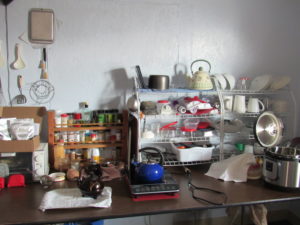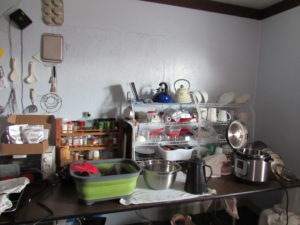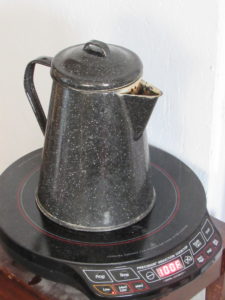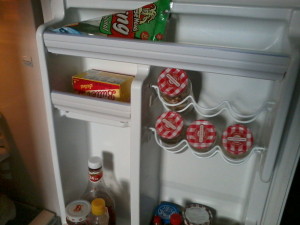This might be helpful to others living in unconventional or under-construction spaces. You can eat quite well without big, expensive, hard to move appliances. While I draw inspiration from the Tiny House Movement and camping community, I do rely on having a reliable electric power supply. So much of what I do is not applicable to off-grid living unless you have a major solar collector.
The kitchen area is centered on an office table that my landlord provided. I experimented with an island-type setup, but settled on this configuration after a few weeks. The wire shelving was formerly used for storing linens, wooden spice rack is DYI. There are two shelving units to the left of the photo to store pantry items and additional cookware.
Equipment includes:
- Krup’s toaster oven bought in the 1990s at Boston Store in Milwaukee. It has survived quite a number of moves and being dropped. Although it looks rickety it still works! I use it most often for making coffee cake or scones.
- Ambio portable induction cooktop, an Aldi Find. Will boil enough water for a pot of tea in minutes. I use it with an 8 inch cast iron skillet to fry an egg and warm tortillas for breakfast most mornings — about 5 minutes prep time. This is my second induction cooker.
- Instant Pot 6 quart Duo mail ordered from Amazon. This is my newest cooking appliance, great for soups, stews, steaming veggies, cooking dry beans and rice, and making yoghurt. I eat a lot of rice and considered buying a dedicated rice cooker but the ones that will do a good job on brown rice can be quite expensive. So I opted for this multi-use appliance instead. It is geezer friendly too — plenty of safety features plus it goes into “keep warm” mode after the programmed cooking time expires. If you forget, you will have serving temperature food.
After preparing food, I unplug the induction cooker, wipe and dry it, and set it aside to make space for dish washing. This is the way we did dishes on the kitchen table when I was growing up!
- Collapsible dish draining rack with drain plug, an Aldi Find.
- Large stainless steel bowl for washing.
- Garment from the recycle bag to absorb water spills. Low tech, plus unlike the commercial dish drainer pads, you can throw it into the regular wash and it dries quickly.
- Granite coffee pot with hot water (see below) for rinsing.
Like much of the rural housing in this area, well water is non-potable due to fossil fuel extraction activities. I bring in spring water or buy bottled water for consumption. I use a NuWave induction cooktop, bought at local Kitchen Connection store, for heating the well water for washing up. I replaced it for my major cooking when the plastic membrane over the control buttons started to deteriorate. Granite ware, like many use for camping, works well for induction cooking.
10 cubic foot Haier refrigerator bought from Lowe’s, with a scratch and dent discount. This is my biggest appliance. I cook most of my meals from scratch because of health, economic, and environmental considerations so the separate freezer section is a real plus.
All the photos in this post except the one of the refrigerator were taken with the new Canon SX350 HS camera. Still have plenty of bells and whistles to investigate.





